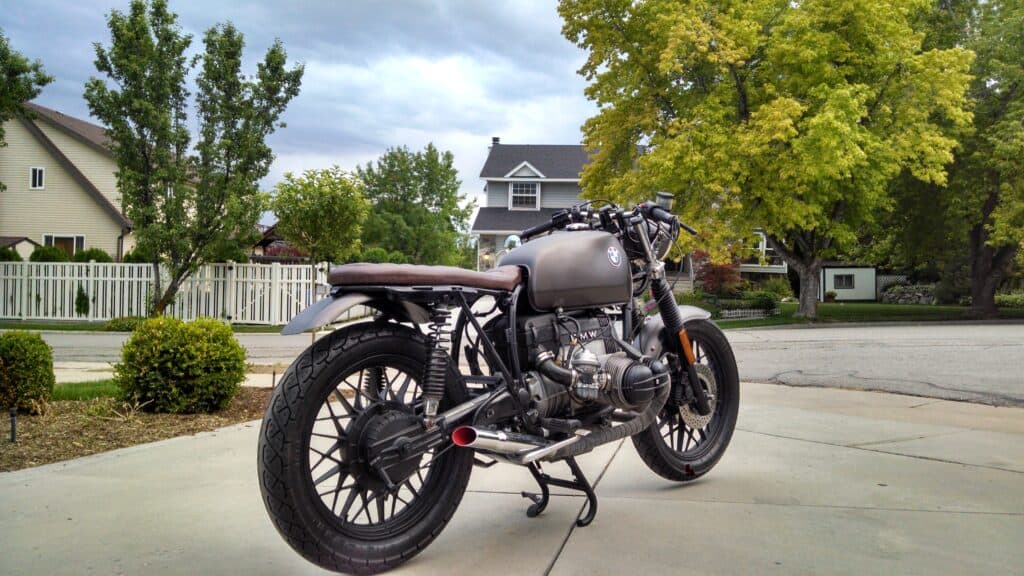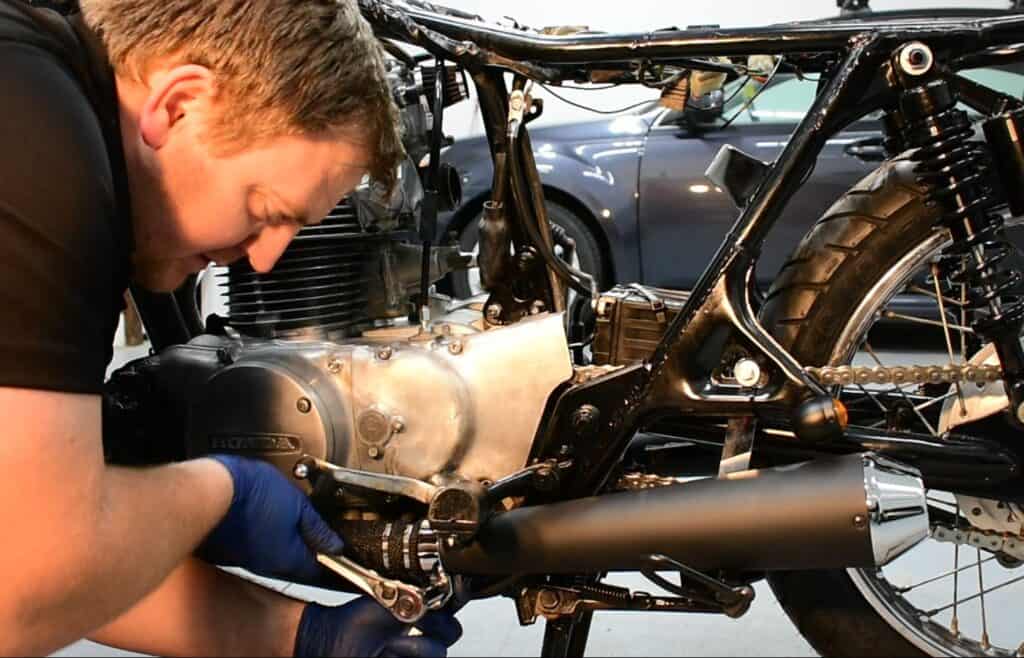
One of the most commonly talked about systems on a motorcycle is the exhaust. People talk about the exhaust affecting the way that your motorcycle sounds, drives, and accelerates. It’s also integral to how well it idles and rides, but very few people understand why.
How does a motorcycle exhaust system work? A motorcycle exhaust system works by directing the post-combustion gasses from the engine cylinder and away from the driver out into the atmosphere. Exhaust pipes are also used to help the engine run smoother by supplying back pressure through pipe length and cross sectional area.
If you have ever accidentally touched a hot exhaust pipe, you will have at least some idea of the temperatures that exhaust gasses can be. The exhaust system makes sure that these hot gasses go somewhere more convenient and safe for you as a rider. We’ll go through in more depth about how a motorcycle exhaust works and how it can affect a motorcycle’s performance.
How Motorcycle Exhaust Works
So how exactly does the exhaust system work on a motorcycle? I’ll get a little nerdy here and put on my mechanical engineering hat for a second. First of all, your exhaust takes the post-combustion gasses out of the engine. They travel through the header pipes and back out towards the exit of the exhaust. These gasses are extremely hot and travel extremely fast.
As these gasses pass through the exhaust pipes, there are sections of the pipe where it will widen. This widening of the exhaust pipe allows for the exhaust gasses to expand. This will send a wave of pressure back towards the engine. This is referred to as back pressure.
This back pressure makes its way back to the cylinder. As it arrives at the cylinder it creates a pressure differential. This helps the engine to function more efficiently. This is one characteristic of a motorcycle exhaust that is often overlooked. Without this back pressure, the engine would backfire when decelerating.
Your exhaust system performs another very important function apart from just routing exhaust away from the rider. The exhaust system is specially designed in order to create back pressure that will help your engine run efficiently. Without this function, you would notice a drop in both fuel mileage and low-end performance.
If you’ve ever heard the term “straight piped,” it’s referring to no cross sectional changes in the the exhaust pipes. When pipes are short and straight there is an increase in horsepower, but a decrease in idle quality and fuel economy.
By purchasing a performance exhaust, you are able to allow the air to flow more freely. This can reduce the amount of work needed by the engine to push the exhaust out. This can also help optimize the amount of back pressure supplied by your exhaust system.
Internal engine temperatures can be extremely hot. Inside of the engine, fuel and air are being mixed and ignited. This explosion that drives the motorcycle is also creating a ton of heat. This heat has to be carefully routed away from rider and any passengers as it could be dangerous if it came into contact with them.
As a result of combustion, your engine can produce several toxic gasses. You do not want to be breathing in these gasses the whole time that you are riding. By routing these gasses through your exhaust system, they are pushed away from the rider and any passengers.
This way, riding a motorcycle is not a horrible experience of choking on carbon monoxide. Your exhaust system is critical to achieving even the slightest level of comfort on a motorcycle.
How Does Exhaust Affect Motorcycle Performance?

You may have considered purchasing a new exhaust for your motorcycle. How can these systems actually increase your motorcycles performance? Your engine is constantly doing the same thing over and over again. To increase your engines performance, you need to make it capable of doing that same thing even faster and more efficiently.
In order to increase the engine efficiency and overall performance, there are a lot of things that can be done. The exhaust is one of these things. After the combustion occurs in the engine, the engine must push out the exhaust gasses through the exhaust system. The better the exhaust system, the less work that the engine must put into expelling the exhaust gasses.
What makes an exhaust better is that it is more free-flowing or less restrictive. As less work is needed to push out the exhaust, more of that generated energy can be used towards acceleration.
Obviously, your engine will always be limited by the weakest link. Just getting a performance exhaust may not be enough to notice any huge differences in your engine’s performance. As previously mentioned, there are tons of different things that you can do in order to optimize your engine performance.
These are things like getting more fuel to the engine, compressing the air as it goes through the intake, or even boring out your engine cylinders wider. All of these things can provide benefit on their own, but together the gained performance will be most noticeable. This is a result of your engine not being largely limited by any single component.
Is It Bad To Run A Motorcycle Without An Exhaust?
Can you drive a motorcycle without an exhaust? Does it hurt anything? The truth is that you can although there is no performance benefit to doing this and it’s dangerous. Having an open exhaust can allow for more horsepower but your engine will not run correctly if there is no exhaust pipes at all.
Unfortunately, this increase in horsepower is generally only seen at high revs. At lower revs, not having exhaust pipes can hurt your performance. As such, using an open or unmuffled exhaust is generally only beneficial if you are taking your motorcycle to the drag strip. Any other application generally will not benefit you.
While driving without an exhaust will not damage your engine, you generally are not going to get what you want from this. Even after extensive tuning of the motorcycle, there are generally still strange blips on the torque curve after using an open exhaust. That is why this is generally just reserved for drag bikes.
Lastly, running your motorcycle without an exhaust is not legal. Be sure to check your local, state, and federal laws for how many decibels your exhaust can be without being illegal. These can vary place from place, but most places do not allow for straight piped or open exhaust unless you’re at a race track.
Particularly, states that require inspections will not allow this at all. So, in general it is best to find a nice performance exhaust to replace your stock one if you are wanting to do something about it.
Engineers spend a significant amount of time perfecting exhaust systems to optimize the horsepower and torque that you are putting out. It is usually best to just trust the experts that have been designing exhausts for years.
Can You Put Any Exhaust On A Motorcycle?

So, what exhaust should you get for your motorcycle? Can you just get any exhaust and bolt it up? These are both hard questions to answer as what kind of exhaust you need can largely depend on the way that you drive. For the most part, there are two different types of exhaust systems available.
The first is just a muffler. These exhaust systems will use your factory head pipes but give you a replacement, less restrictive and generally louder muffler. The other choice is a full exhaust system that will replace everything.
Replacing just the muffler is much simpler than doing a full system. The muffler systems are generally just a simple bolt on replacement. While being cheaper and simpler, they usually offer less performance gains as you are still slightly restricted from the stock exhaust pipes.
While a full system will offer much greater performance, they are harder to install and more expensive. Most of the time, you will also need to upgrade your fuel system in order for it to work properly. This could be installing a fuel controller or a larger jet kit.
There are also a wide variety of different materials that you can purchase. Stainless steel, chrome, aluminum, titanium, and carbon fiber are all options that offer different benefits.
Lastly, you will need to consider how you want the exhaust outlet to be. There are tons of different styles that you can search through.
Be sure while looking for an exhaust that you look for one that will fit and work with your motorcycle. Not every exhaust will fit and work with every motorcycle. It is usually best to look into make and model specific exhausts to be sure that you find one that will fit perfectly on your model. These exhausts are specifically designed and optimized for the engine application to which they go.
I once made the mistake of buying “universal” exhaust for one of my motorcycles and noticed it just wasn’t working right. I was trying to be cheap. Had I spent another $20, I would have gotten the right one and made the motorcycle sound amazing (which I eventually did!)
Conclusion
Understanding how a motorcycle exhaust works reveals the intricate balance of performance, efficiency, and sound management that is often overlooked. The exhaust system is not just about directing fumes away from the rider; it plays a crucial role in engine performance, emission control, and the overall riding experience.
Having restored almost two dozen motorcycles, I’ve seen first-hand the importance of the exhaust system and how it needs to be handled appropriately, mostly for the safety of the rider. If you have any more questions about how a motorcycle exhaust system works, feel free to contact me directly through our “Contact Us” page!
